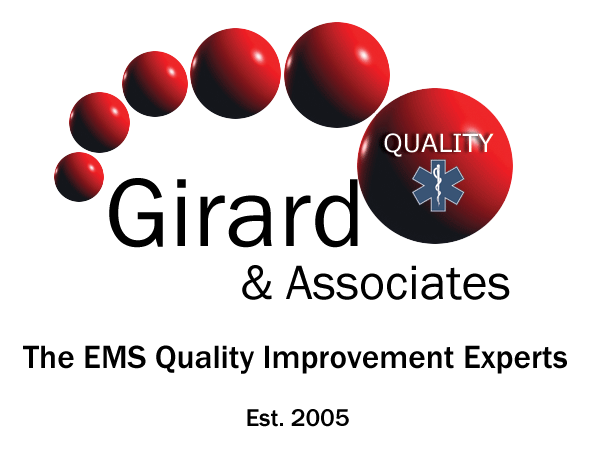You have been given the task of establishing a quality assurance/quality control program for your department or agency. Your boss tells you, “I want you to look at some of our PCR’s and make sure that they are up to snuff!” You have no parameters to rely on; you don’t know if you are to review an entire month’s worth of patient care reports or just a “sampling”. Are you looking at only billing demographics because without that information, your department isn’t going to get paid? If you look at the narrative, how do you decide if the care provided was according to protocols or even provided at all?
If you decide on reviewing just a sampling, which do you review? If every PCR needs to be reviewed, do you have the time between calls, house duties, training and other departmental or agency requirements? Suppose you work in a system where you are responding to three or more calls per day? Can you do an adequate job? How do you gather the data and what do you do with it once you have it? Who is going to look at it? What if there are serious problems or issues; how do you address them and to whom? What if the report in question is your partner’s? What if it is yours? Do you hide it in the bottom of the pile or run it through the shredder?
Throughout our EMS careers, we have heard the terms, “Quality Assurance/Quality Improvement” but do we really know what those terms mean? Continuous Quality Improvement or CQI is often much maligned as the “internal affairs division” of any EMS agency and that their job is to police everyone and to discipline those who fail to measure up or fill out their PCR’s correctly. The term is sometimes applied to someone who looks at a run report to ensure that the billing information is correct because that is how the service makes money. Without the patient’s name, date of birth and insurance numbers, and the Medical Necessity Form, the PCR cannot be submitted for payment.
Sadly, CQI is the stepchild of EMS. It is often an afterthought and then only when inspectors ask to see run reports and point out areas they perceive as “needing improvement”. In reality, they may not be appreciating the full scope of what a particular report says. Serious consequences may result should a civil tort be filed, and the service and its run reports be called as evidence. “If you didn’t write it down, you didn’t do it” has plagued many EMS agencies and individual providers.
Where do you start to create a Quality Assurance Program? You must have a reference point. Most important are the answers to these or related questions:
- what objectives are you trying to achieve?
- what are you looking for overall and how do you gather that information?
- what resources or guidelines are available to you for reference?
- how do you use the data once you have received it?
When you have answers to these questions, you can begin.
The main objectives of a comprehensive CQI program must be:
- to improve patient care
- to establish consistency
- to learn how best to identify and fix existing or potential problems before they become serious.
CQI should be geared towards problem identification, remediation, education, and constant, consistent follow ups and less towards disciplinary actions.
All EMS agencies/departments should have comprehensive CQI programs. Many, however, lack these programs, due to time and manpower constraints, lack of budgetary and “in-house” support.
To develop a comprehensive CQI process, there must be guidelines that start at the state regulatory departments. In Massachusetts, EMS services are governed by the Office of Emergency Medical Services (OEMS) within the Department of Health. This Body establishes the regulations and licensure requirements under which any EMS agency in Massachusetts, private, municipal or third service can operate. It is responsible for establishing and implementing policy providing for statewide treatment protocols, training, and inspections. What the state failed to do was explain how to accomplish this. Lacking guidelines, some services tried to create a framework to comply with the state regulations.
Many could not and thus failed in the attempt.
The few services which have established some kinds of process have used the state protocols as a starting point. Most states have treatment protocols outlining specific steps that EMS providers can or must follow when treating certain medical emergencies. In some areas, these protocols may be modified regionally by the local governing Body. This may include not only EMS providers, but physicians, nurses, fire/police chiefs or other involved personnel. This Body may prescribe a modification of the statewide treatment protocols to fit their region’s needs. Implementation of this often creates confusion under these circumstances:
- Some services may provide EMS coverage for overlapping regions/districts. These services may transport to a medical facility which operates under a different set of protocols,
- Personal interpretations of the statewide treatment protocols by medical directors, (often physicians), and finally,
- Online medical control physicians who may not be familiar with the protocols when the transporting service is from another region. The on-line medical control physician may decide that the treatment was inappropriate even though it was correct under the transporter’s rules.
In order for a comprehensive quality assurance/quality improvement system to be established, a number of conditions are necessary:
- State and local protocols and regulations must be coordinated. A regulatory body that establishes requirements, and then allows different regions to modify them to fit their own perceived needs creates only confusion. This translates into ‘what is good for one is not good for another’.
- The goals of CQI are to improve quality and maintain consistency of patient care. Those goals and how to achieve them must come from the combined input of medical and EMS professionals. The overall authority can be the OEMS but must include regional medical directors and on-line physicians who would be giving medical direction to the EMS providers.
- The governing authority should include EMS professionals, administrators, EMS medical directors, “street” medics and training facilitators. From this base, data will be collected and analyzed, and a protocol established.
- Guidelines must be established which must include statewide protocols and, in some instances, local areas of interest, (e.g., on scene times) or specific areas of continuing education or study such as the effects of high dose NTG for cardiac patients, can be included.
- Processes and tools need to be developed to allow accurate data collection and processing. Computer databases are available to allow information to be entered and analyzed to identify specific areas of concern or study. For example, it is useless to have someone count successful IV starts if there is meager supporting information to determine if the IV was warranted, started successfully, and was properly documented. This would include any starts that were unsuccessful and who started or attempted the IV.
- Financial backing is universally necessary whether a department or agency does their own “in- house” QA system or hires out to a private professional firm. This includes support at local and state levels. Services which invest in a proper quality control system may find that their liability costs will decrease, and its revenue increased, provided that it has an effective problem-solving system in place.
Many EMS services are unsure of the proper method of instituting CQI. There are professional firms who specialize in quality control data analysis. They have teams of EMS professionals who analyze patient care reports and enter information into a database to determine what went right or wrong. They then meet with the interested agencies and provide a review of specific cases or general issues under the direction of a medical director who, in most cases, is a physician.
Advantages to private firms such as these are:
- They are unbiased, thus eliminating the possibility of conflicts that can occur within “in-house” systems.
- Their data collection is customized for individual agencies/departments needs/wants and areas of concern and/or study.
- Data is compiled using resources and personnel not affordable or available to most EMS services. Lack of expertise can result in misinterpretation of data yielding false conclusions.
Each service’s data is protected and kept confidential. Upon request, the agency or department administrator can obtain a report that can range from a brief summary to a comprehensive analysis. This can report on individuals or the overall service performance.
Some firms offer a full remediation/education process. By using the reports to identify problems, education becomes the key to establishing an ongoing maintenance plan. Remediation services are offered should situations become critical requiring immediate intervention.
Employing a professional CQI firm is not prohibitively expensive. If an administrator were to examine his/her budgets to determine if it would be cheaper to establish an “in-house” CQI system, they may find it is actually cheaper to outsource it. “In-house” systems come with a built-in conflict. The QA coordinator has to remain objective, and this is difficult, particularly when there are issues pertaining to “partners”, “friends” even senior or ranking personnel. Maintaining a professional objectivity throughout all phases of the process eliminates the impression of unfairness. Additionally, who reviews the reports of the “reviewer” and what if his/her reports are not in keeping with the standard of care? How are they held accountable?
Other issues include:
- Not enough time due to constant interruptions
- Lost time due to illness/injury or time off
- Delays in getting the data compiled, analyzed and a plan of correction developed because of any of the aforementioned issues
- Finding the right person to do the job.
Budgets are especially tight with current cutbacks in Medicare/Medicaid reimbursements and HMO’s are examining reports more closely looking for any reason to reject payment. Even though states may mandate that certain services be rendered, they are not the ones who are forthcoming with the finances required to meet the criteria. When services are relying on every dime in order to stay in business, the last thing they want to pay for is a CQI system, whether in-house or outsourced. So where does the money come from?
Grants are a very real possibility. Some insurance companies may provide grant monies to services that can show that CQI, by tracking potential problems, offering education and remediation, may be able to lower the instances of civil liability litigation and improve patient care. Involvement of local governments is essential. Many of us have attended town meetings, committee hearings and the like, to discuss the local budget, the value our service provides to the community and the impact of budget changes on those services. However, what few local authorities have failed to look at is how well their ambulance service is performing in treating patients.
An example of this comes from a town in Massachusetts which has an established EMS committee. It provides oversight of the EMS service and assists in contract negotiations, handling of concerns of or about the provider and holds the EMS service accountable for its actions. The EMS committee, representing the town in contract negotiations, took the unusual step of adding to its ‘Request for
Proposal’ (RFP) a clause which required the EMS provider to contract with an outside quality control management firm. This firm would present to the committee and provider, data which would show areas where the service excelled or where improvement was needed. They would provide data from patient care reports in which the patient care had been questioned and had been reviewed by a physician. This physician could accept the firm’s assessment of the report, or he could upgrade or downgrade the score. By receiving this data, the town gained a better understanding of whether their EMS service was providing care that met or exceeded the minimum standards of the state governing body. This idea was initially met with some resistance but when the committee was able to have an “eyes, ears and hands on” understanding of what the provider was doing, and of what their tax dollars were paying for, they realized that this information could also be used in future contract negotiations.
Quality Assurance and Improvement are an essential part of any EMS system. Without a comprehensive CQI program, trends and issues cannot be identified in a timely manner. Without identification they cannot be addressed in an educational, remedial manner. CQI is a powerful tool for improving patient care, but it must be effectively implemented.
Without an effective quality management system, all EMS services, public, private, or otherwise are leaving the door wide open to liabilities which in the end can and will cost more than if the service was more proactive to prevent or minimize errors in patient care. To be reactive when a less than desirable situation has already occurred is folly. To be proactive before it occurs puts your personnel, your team, and your service at less of a risk for error and legal liability and keeps your name out of the local media.



